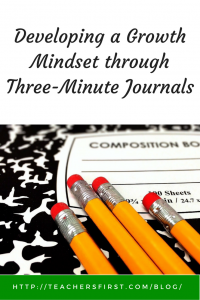 One of the hottest topics in education is Growth Mindset. Inspired by Stanford University psychology professor Carol Dweck, it is the belief that the brain is like a muscle that can grow stronger through hard work.
One of the hottest topics in education is Growth Mindset. Inspired by Stanford University psychology professor Carol Dweck, it is the belief that the brain is like a muscle that can grow stronger through hard work.
An article published in U.S. News and World Report provides more information on this topic including information on how it is being misunderstood. In this article, Dweck states “You can’t just declare that you have a growth mindset…Growth mindset is hard. Many educators are trying to skip the journey.”
One method for building a growth mindset is for students to see and recognize their own academic growth through the use of journal writing. Specifically, through a technique known as a three-minute journal. When done properly, these journals offer students and teachers important information on student learning.
Take advantage of three-minute journals with any subject, let’s take a look at how to do this with math:
- At the beginning of a new unit, for example 4th grade fractions, have students use their math journal for a three-minute writing session with the prompt “Tell me what you know about fractions”. Before writing, allow students one minute of think time to process what they might know.
- Some students will say they don’t know anything about fractions, don’t know what to write, etc. This is when you need to let them know its ok not to know anything. Encourage them to write what they don’t know how to do, draw pictures, or share problems that they know how to do or would like to know how to do. Just make sure they are putting something down in the journal! At first, you will have to be very vigilant and continue to encourage students to write the whole time. It is important that they use the entire time to write or draw something.
- Stop promptly at the three-minute mark. This is not a writing exercise; it is an opportunity for students to start thinking about prior knowledge.
- Ask if students want to share, but don’t make it mandatory. I have found that once one or two students share, the others become comfortable with sharing what they have written. This is also made possible by a continued development of a positive and encouraging classroom culture throughout the year. Sharing also helps to point out what students may not have realized they already know!
- You will find as you teach your unit, students point out information from their journals. They are starting to recognize and understand their learning process.
- At the end of the unit, do another three-minute journal writing activity with the same prompt and same think time before writing. Students love this activity because they look back at their earlier writing and understand that they have made growth in learning the concept. This is where the growth mindset really takes place – the student has a very concrete example of their learning. An added bonus is that this activity differentiates for all students, they know their own starting point and can recognize how much learning has taken place. You may also find that students don’t want to stop writing at three-minute mark because they now have many things to share!
It is very important that this technique be utilized with a very short writing time. The focus is on the content, not the writing. I would suggest no longer than 5 minutes with older students.
Here are some other ideas for successful use of three-minute journals:
- Use one notebook per student for journaling throughout the school year. This creates an ongoing record of learning.
- Keep journals in the classroom. You don’t want to take the chance of losing journals.
- Share journals with parents and students during conferences to highlight student growth.
- Because this is a very quick activity, use paper and pencil instead of doing this on computers. If you want to add this to a digital portfolio, take a picture of journal entries and upload to your portfolio site. Seesaw is an excellent digital portfolio tool to try.
- Students as young as 2nd grade can do this three-minute activity. For K-2, do this together as a class activity. Of course, it will take longer due to recording this as a class. Be sure to label individual student responses so that you can refer to them as you create your end of unit list. Although this sounds similar to a KWL (what you know, what you want to know, and what you learned), it is different because we are only looking at prior knowledge then highlighting the learning on an individual basis.
- You may need to make allowances for students with special needs. Instead of writing, allow them to tell their response to you or an aide to write for them. Another option is to allow them to use an online text to speech application such as Talk Typer to record what they know about the content.
- Be specific with feedback from student learning. Allow students to discuss their pride in learning concepts and share their struggles along the way.
- Be sure to look at individual learning, each student will have growth in different ways and at different rates. Point out specific examples of new learning.
Growth Mindset is a powerful way to motivate learners to the power of their own mind and to recognize the ability to learn. Three-minute journals are just one method for recognizing and teaching growth. Have you used journals to encourage a Growth Mindset? What other tips do you have? We would love to hear your thoughts in the comments.


One thought on “Developing a Growth Mindset through Three-Minute Journals”